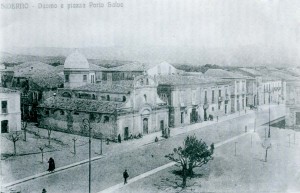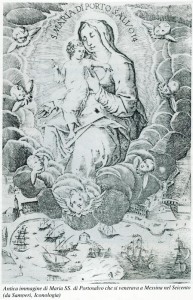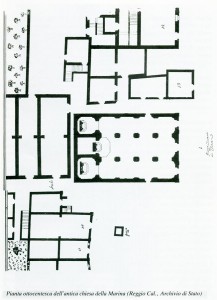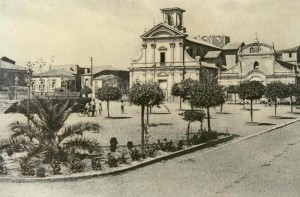THE ANCIENT CHURCH OF SANTA MARIA PORTOSALVO
II 22 October 1671, SINCE carry to Rome the personal effects of the outgoing bishop Vincenzo geracese Vincentino, is noleg-GIATA Messina (but the contract was signed in Gerace, through a public deed notarized by a notary Mario Gualtieri) the boat “Santa Maria di Portosalvo”, a padron Placido Novel.
The fact confirms the existence of trade and business among our area and Messina, and suggests that the dock for boat master Romano to our shores could not be episodic. Should this hypothesis be tolerated, could therefore imagine that it was founded by its crew master the Roman church dedicated to SM. of Portosalvo that soon we will see documented on the beach in Siderno, next to the old watchtower, at least the last quarter of the seventeenth century, individually coeval with the attendance of the homonymous boat Messina.
This fascinating combination is perhaps arbitrary, but it must be proposed if – how will shortly – I can just backdate about 80 age (approaching so significantly to 1671) the oldest news we have of our church.
So far, swearing on the authority of Archbishop Antonio Oppedisano, it was always said that the earliest mention of our church did not exceed half of the eighteenth century; rather, Our ensured that “had to be established after the 1755 why not clear from the documents of S. Visit of Bishop Rossi”. He also reported that “in ancient times, long before there were church, (. . .) beach Siderno stood a chapel dedicated to Our Lady. of Portosalvo. It was built by sailors, at the old tower.
The Oppedisano does not mention the source of his information, and therefore it is not possible to assess the reliability, but I believe that the succession “cap-Pelletta” – “church” should not be taken into account, is irrelevant because liturgically, both because – as we shall soon – in fact, the first statement of our is incorrect, the existence of the church being mentioned in their acts from which he excludes, that the minutes of the first S. Visit to the Diocese of Cesare Rossi. Therein, under the date of 31 (sic) November 1750 states that the Bishop Rossi, returning from Grotteria, passes from Marina di Siderno and, ” equo desidiens, visitavit ecclesiam, which was set up near the sea shore”.
This is just our church, but, unfortunately, the paper is intended to receive the report of the visit is hopelessly white, with the header only “De Ecclesia maritima S. Except mob of Portu Mariae”. It’ a serious gap: in fact, if he had written report, Bishop Rossi, as usual, would have left the building description worship, and would have transcribed all the historical information available at the time. What remains, however, documents the existence of the church as early as 1750 and denies that “had to be established after the 1755 “. At this point, but, should seriously consider another interesting document, hitherto relied on in connection with our church. This is one of the bells of the church of Santa Maria. Arch of Siderno Superiore, which bears the following inscription:
1693
+ S. M HIA PORT
SAVE TIME PRO NOBIS
FOR devotion OF
Gioseppe CORSARO
That the bell might have belonged to the church of the Navy I had suspected since I was aware dell'iscrizione6, although she seemed extremely difficult to ascertain the circumstances of the apparent transfer. Instead, the instance that follows, I have found in the State of Reggio Calabria, finally reveals the “mystery”.
Here is the text:
To His Excellency
II Sign. Intendant of the Province of Reggio. Excellence.
The inhabitants of the Marina Siderno expose, that the care of their church under the title of S. Mary Portosalvo had a bell owned by that church, made from one hundred, years and more functions for use in the Holy, as the whole ritrovasi the inscription in said bell. Meanwhile, the Archpriest of abusing Siderno, are about eight years, that this population deprived of such a bell having it transferred to Siderno for use of his church. Or as a bell that is of the utmost necessity in this Church for having greatly increased this Undercommon, and also because it belongs to straight, therefore resort to justice E. S. evil Ella ordinasse, that the aforementioned bell was returned to that Church of Port-except.
And will have a grace, as from Heaven.
Vincenzo Audino Ec. taken care of that Church – Fortunato Macri – Nunziato Polimeni – Domenico Congiusta – Antonio Francesco Rispoli-Audino – Gaetano Maresca – Giuseppe Domenico Macri-Romeo – Thomas Fassano (?) – Antonio Savarese-Vincent Galluccio – Vincenzo Romeo – Rocco Oppedisano-Carlo Macri.
Claimed that the bell was what is now the bell tower of SM. Arch seems to me that it can not be doubted. A me, in real-ty, This seems quite indisputable and therefore I can say that our church already existed at least in the 1693, date, as seen, is quite close to that of the deed mentioned at the beginning, documenting the attendance of our coast in the seventeenth century by the Sicilian sailors devotees of Our Lady of Portosalvo.
 In Messina, the cult of Mary. of Portosalvo dates, according to the Samperi, at least the fifteenth century; in Calabria, even in Reggio Calabria Ionian-, it is documented in the early '600 to Reggio and 1637 the Melito Porto Salvo.
In Messina, the cult of Mary. of Portosalvo dates, according to the Samperi, at least the fifteenth century; in Calabria, even in Reggio Calabria Ionian-, it is documented in the early '600 to Reggio and 1637 the Melito Porto Salvo.
As we can see, nothing is opposed to that on the beach in Siderno may have been built a church dedicated to SM. of Portosalvo during the seventeenth century. It was a church without care of souls, “guarded – writes Oppedisano – by two hermits”. That too is omitted news source, and you do not know what value to attribute. Some, the church served the farmers of the surrounding countryside and the inhabitants of the few houses in the seventeenth – Eighteenth century were built in the shade and under the military protection of the watchtower. There is of course celebrated the Mass at least festive and, occasionally, some wedding ceremony. Francesco Prati, one of the historians of Siderno, claims to have read, recorded in the appropriate book of the parish church of Siderno Superiore (fell within the jurisdiction of the Navy), the act of marriage between Nicholas and Cecilia De Francesco Misuraca, cele-brated in the church of the Navy 5 February 1770. That register is now untraceable, but there is no reason to doubt the statement of the Meadows. From the second half of the eighteenth century, on the other hand, you begin to have more detailed information, such that we can reconstruct with some confidence the stages of growth of our town and the church. Of this, rather, drawn up 30 July 1784 Cash for Sacred, we have an inventory of assets, from which it follows that the avail-neva, in that age, a liquid capital of 75 ducati, given wealth to eight people to the interests of 5%, and 5 small buildings (“that”), site around or adjacent to the church, rented for a total of 8 ducati. In the same church there seems to be, then, the chapel of S. Lucia, who owned 13 mulberry field in the districts and Casanova, tomolate 3 1/2 of land planted with vines in the regions of Drum and Fronzato (given colony) and 5 censi. The boom demographic Marina Siderno is related to the consequences of the disastrous earthquake that shook the Reggio Calabria in 1783. From the ancient center of the earthquake Siderno Superiore received significant damage, such that many of the inhabitants decided to move his residence in safer Marina. In the space of a few months we gathered about 300 people, many that the bishop geracese era, Pietro Domenico Scoppa, deeply concerned about their spiritual needs, the 14 February 1786 appointed a treasurer residential care, Don Leonardo Trento, with the faculties to celebrate Mass and confessions of the faithful in the church.
 Of course, population growth (in 1802 the inhabitants had more than doubled) pointed out the insufficient capacity of the old church, and they had to design the widening. The work was carried (or completed, no one knows) in 1808/09 and the sacred edifice took on the appearance which would then maintained until its total demolition, in 1945/46, three naves, three entrances front, a beautiful dome over the presbytery, a lovely bell tower. Within, stucco and various works of craftsmen and three altars Serresi: those on the sides of the SS. Sacramento S. Francis of Paola, the center of the altar, in whose pediment continued to find an old painting of the place holder and the future of the church patron of Siderno, Maria SS. of Portosalvo. Growing up the country, They looked new problems and needs.
Of course, population growth (in 1802 the inhabitants had more than doubled) pointed out the insufficient capacity of the old church, and they had to design the widening. The work was carried (or completed, no one knows) in 1808/09 and the sacred edifice took on the appearance which would then maintained until its total demolition, in 1945/46, three naves, three entrances front, a beautiful dome over the presbytery, a lovely bell tower. Within, stucco and various works of craftsmen and three altars Serresi: those on the sides of the SS. Sacramento S. Francis of Paola, the center of the altar, in whose pediment continued to find an old painting of the place holder and the future of the church patron of Siderno, Maria SS. of Portosalvo. Growing up the country, They looked new problems and needs.
The Marina Siderno, previously commercial maritime node to the valleys of the Roil and Novito and large cities located therein, developed in a surprising way: “This [Marina] – M writes. Macri, that public its Sidernografìa in 1824 – from which have fixed it in the residence of the employees of the Royal Customs Gerace, has become the emporium of almost the entire province. The comfortable, that there can be found and warehouses and dwellings, attract traders from all over. And consequent, continuously veggionsi the input of supplies, and various other kinds of, that afterwards it diraman’ countries within. Are frequent so the extraction of oil, wine, figs, of silk and other commodities indigenous. Notisi, that in winter time the naufragoso Gulf sidernate in a few hours it becomes a chaos of sparkling waves; so that the wood proceeding from Greece, and the Adriatic Sea, overwhelmed by contrary winds, very often there will’ old days were wrecked. Fassi there, in force di royal decree’ 18 August 1819, from the day 3 to 8 September of each year a large fair; during the celebration of the feast of Our Lady of Portosalvo, title of the three-nave church. Sonovi already established there fondachi with some merchants from Amalfi and Sicily”.
From 1819, therefore, began to unfold the fair, popular and fre-tissima until a few years ago. It was essential aspect of the festival was organized annually in honor of the patron saint, which, in the same 1819, to replace the (and no longer exists) picture, was commissioned in Naples wooden statue that still remain faithful to venerate. The continuous progress of the Navy began to bring the issue of the institution of the parish. As far as we know, the first bishop to put this matter in its pastoral plan was Giuseppe Maria Pellicano, who held the chair from 1818 to the 1833. The documentation for this intention clear not only from the three-year relationship ad limina Apostle-rum ', but also on the cards that are read in open practice with the civil authorities with a request to transfer to the Navy one of the parishes of Siderno Superiore. The parish “sacrifice” seemed destined to be that of the SS. Annunziata, but nothing came of it, almost certainly for the reactions of those parishioners. Meanwhile, as has been said, Don Leonardo Trento had succeeded, towards the end of the century, another economist, Don Giuseppe Giacomo Macri, which soon (towards the 1819) was added, as assistant, Don Vincenzo Audino. In 1826 Macri asked the adaptation of livelihoods. Evidently because it had a negative response, or also for other reasons more personal, towards the 1830, he went to Italy and became treasurer Audino cured provisional. But it was, for the Audino (that, with the Macrì, from the economic point of view, had enjoyed only occasional awards, cute and random), of a solution very precarious, also considered the growing needs of the country.
He realized the Bishop Perrone (1834-1852), which, with its bubble 20 March 1835, considered the merits dell'Audino, decided to appoint the treasurer care estab-, giving it the power of their economic cared for and assigning the annual salary of 36 ducati (by the Municipality), in addition to the rights arising from the management of the church. Only those marriages (but the publications would always be made in the church of Portosalvo for obvious reasons of advertising) continued to be covered by the archpriest of Siderno Superiore, falling under the jurisdiction of the Navy parish. Everything was pastorally and canonically supported with due consideration of the needs of the increased population of the Navy, that grew dramatically from year to year (also thanks to the contribution of many merchants settled here for reasons of commerce), and that, moreover, were scattered over a vast territory.
From the economic point of view, the condition determined by the decisions of the bishop Perrone proved still inadequate. 136 ducati assigned Bursar planned not only were paid by municipal administrators grumbling among many, but were insufficient for the adequate means of livelihood of the priest. So it was that the bishop Perrone resorted to a more appropriate. Taking advantage of the holiday dell'arcipretura Siderno Superiore, the 7 August 1837 dictated a decree that, noted that it was right to protect the rights, especially those of the double tax – Archpriest, but it was also right to take due account of the increased duties of the Bursar Portosalvo, it elevated the salary 60 ducati. This salary was paid archpriest, that would cover with 36 ducats of the City and the rights available. If this option is not going to archpriest genius pro tempore, then the treasurer would have directly the 36 ducats paid by the City and could freely dispose of all taxes collected in the exercise of its functions, including those established for the celebration of marriages. The explicit acceptance of the decree – established the bishop – was a prerequisite to be able to compete ali'arcipretura Siderno Superiore.
Despite not having solved the problem of the parish, our church-sa, gradually growing the country, was becoming increasingly important. It was now subject to regular pastoral visit of the ordinary Gerace30, and, even, the 19 May 1846, saw kneeling within its walls the King and Queen of Naples (Fernando II, Maria Theresa of Austria and the future Francis II), which, arrived in Siderno on a steam frigate, after being brought to Agnana to visit the coal mine laid open, in the afternoon they returned to the Navy, where, received by Bishop Perrone, is brought into the church, “and the public was built dahlia religiosity of His Sovereign”.
The visit of the King and the large crowd that gathered for the occasion you did, but, observe, again, that the church was really too small. In a report on the “State of the churches of the City of Siderno”, signed by the mayor F.A. Falletti the 22-7-1847, states that it is “in excellent condition, but insufficient to growing population that feels the need to set themselves up in the Marina a new larger church”32. But, there is no news of initiatives in this direction. More concretely, instead, the Curia geracese worked for the establishment of the parish. In 1854, followed the vacation of S. Maria Arch to the death of the priest Giuseppe Nicola Falletti (13-7-1854), you gave start to work for the transfer to the Navy of that entity parish. Again, the initiative failed for the reaction of parrocchiani33, but the long-awaited measure – made to him take a different route, the erection ex-novo – suffered only a few years later, the time to complete some preliminary. Before, the 14 May 1857, chaplains were appointed supernumerary Portosalthe of all the priests residing in Marina; then, the 10 March 1858, the council had to take on the burden of raising from 36 a 100 ducats a year the fair of the future priest; the 18 July 1859 was granted the R. Assent, and finally, the 12 August 1859, Bishop Lucia erected the parish and appointed the first parish priest Fr Vincenzo Audino, who took possession of the 15 August.
Indeed, everything is brought to completion by the insistence of the bishop and the sensitivity of the civil power. There was little enthusiasm in Siderno Superiore. Therein, municipal authorities resented having to bear the expense of 100 ducats a year for the parish fair. That, rightly, observed that, for the maintenance of the parish, could be assigned to the parish pro-tempore of the old benefit Salvi and Pizzillini, the value of 200 ducati. Tale benefit, which was of R. Patronage, was assigned, instead, the priest Paolo Romeo, the philosopher, called to Naples to practice teaching in a high school. The bishop said he was in favor of such a solution, soon, rather, to assign to Romeo, if degrees-to, the office of pastor of Portosalvo. However, waiting to check availability of this benefit, the municipal authorities had to fold due to assume the burden of 100 ducats a year. Equal discontent came from the clergy, particularly archpriest Marzano: he was the first signatory to an instance addressed the 25 March 1859 to sottintendente Gerace to ask, at least, “the deal [erection of the parish] is time-reggiasse”. Despite all, the parish was still standing. In the bubble, the bishop of Gerace, after you have adequately explained the decision to establish the new parish, indicates the boundaries and set the prerogative courts archpriest of Siderno Superiore, more precisely from now also for when – how many clues they provide – the Navy were separated administratively from the old. The same document defines the prelate “elegant” the structure of the church and “valuable” sacred furnishings of which has.
This was made up of "pieces" benefit - a silver monstrance donated by Francesco Romeo "Bomb" in 1831, a processional cross donated by Domenico Romeo ; a rich mantle embroidered in silk and gold donated by sailors Maiori; some pictures - and objects such as pissidi, glasses, censers. The following report of the Bursar care Giuseppe Sarroino (Audino the pastor was conspicuously absent or infirm) There raggua-glia status of the parish in 1862.
The old and the new church in the thirties of this century
© Edited by Prof. Enzo D'Agostino
